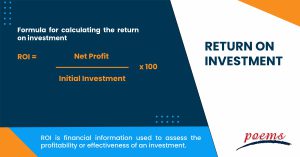Return on investment
Table of Contents
Return on investment
Return on investment, or ROI, is important for individuals and corporations. Decision-makers are guided toward the best resource allocation, risk assessment, and performance evaluation by ROI, which acts as a compass. In the current world, ROI is essential because it enables people, organisations, and communities to make wise decisions, allocate resources wisely, track performance, draw in investments, and promote growth and development.
What is ROI?
ROI is financial information used to assess the profitability or effectiveness of an investment. It measures the investment’s gain or returns on its cost. ROI is computed as a percentage by multiplying the net profit or gain from the investment by the initial investment cost. It helps evaluate the success or performance of an investment by giving a numerical representation of the return received on each dollar invested. Individuals, companies, and investors frequently utilise ROI to evaluate and contrast various investment options and come to wise financial conclusions.
Understanding ROI
ROI aids decision-makers in determining where to deploy resources and evaluate an investment’s possible financial returns. A profit was made from the investment if the ROI was positive; otherwise, it was negative. Projects, marketing initiatives, purchases of equipment, and training initiatives can all be evaluated using ROI. Businesses can improve their profitability and performance by analysing ROI to find improvement areas and efficiently allocating resources.
Calculation of ROI
The following are the steps to follow for the calculation of the return on investment:
- Identify the investment’s initial cost. This sum covers the entire investment and any fees or other costs related to the transaction.
- Determine the net profit the investment produced and can be acquired by deducting the initial investment cost from the investment’s end value or total income.
- Multiply the initial investment by the net profit.
- To express the return on investment as a percentage, multiply the value by 100.
Thus, the formula for calculating the return on investment is as follows:
ROI = (Net Profit / Initial Investment) x 100

Advantages of ROI
The advantages of ROI are as follows:
- ROI offers a precise gauge of the effectiveness and success of an investment. It enables investors to evaluate the efficiency with which their capital has been used and the acceptability of the returns produced.
- ROI is a key consideration when deciding whether to move through with an investment, expand a firm, or allocate resources. It offers a measurable foundation for assessing the viability and profitability of different solutions.
- ROI aids in coordinating investment choices with particular monetary objectives. By estimating the projected ROI, investors can decide whether an investment fits their targeted returns and the time frame for reaching those goals.
- ROI makes it possible to keep an eye on your investments. Investors can spot any outliers or areas needing attention by comparing the actual ROI with the predicted ROI. This enables alterations and tweaks to improve investment performance.
- ROI makes contrasting various investment options simple. Investors can examine their options objectively and select the one with the highest prospective returns by calculating the ROI for each one.
- Assessing an investment’s risk with the aid of ROI. By examining the ROI, investors can determine whether the prospective profits outweigh the degree of risk. By taking into account the risk-reward trade-off, it aids in helping to make informed judgements.
Disadvantages of ROI
The disadvantages of ROI are as follows:
- ROI generally emphasizes monetary gains while ignoring other essential elements like social effect, environmental sustainability, or long-term viability. It could fail to consider the hazards or non-financial advantages of an investment.
- ROI calculations measure returns over a given period and are time-dependent. This is a concern when evaluating long-term investments that take some time to start paying off or when comparing investments with different time horizons.
- The timing of cash flows is not considered by ROI. Investments with a slower rate of return but a steady stream of cash may be preferable to those with a high rate of return but erratic cash inflows.
- Risk analysis needs to be taken into account in ROI calculations. High profits on investments could also come with increased degrees of risk, which could result in unforeseen losses or volatility.
- When evaluating several investment options, ROI alone might not give the whole picture. Risk tolerance, liquidity, and anticipated market conditions should also be considered for a thorough examination.
- The method used to quantify expenses and returns may affect ROI estimates. Different ROI calculations based on different approaches may produce inconsistent results when comparing investments.
Frequently Asked Questions
ROI can be used to prioritise and evaluate different investment possibilities by dividing the net gain or benefit by the investment cost, and the method can be used to determine the profitability of investments.
To make comparisons between different periods easier, annualised ROI determines the average rate of return on investment over a year while accounting for compounding effects.
ROI is important in business since it aids in assessing the profitability and efficiency of investments, informs decisions about allocating resources, measures performance draws in investors, and maximises financial gains.
A ‘good’ ROI is a relative term that varies with the industry, the type of investment, and risk tolerance. A good ROI often exceeds the cost of capital or industry benchmarks.
A yearly ROI of around 7% or more is regarded as a good ROI for a stock investment. When adjusted for inflation, this also refers to the S&P 500’s yearly average return. Given that this is an average, your return might vary from year to year, either increasing or decreasing.
The benefits of calculating ROI include assessing the profitability and efficiency of investments, assisting in decision-making, prioritising resource allocation, identifying areas for improvement, measuring performance, luring investors, and ensuring a strategic approach to maximising returns on investments.
Related Terms
- Margin Requirement
- Pledged Asset
- Stochastic Oscillator
- Prepayment risk
- Homemade leverage
- Prime bank investments
- ESG
- Capitulation
- Shareholder service fees
- Insurable Interest
- Minority Interest
- Passive Investing
- Market cycle
- Progressive tax
- Correlation
- Margin Requirement
- Pledged Asset
- Stochastic Oscillator
- Prepayment risk
- Homemade leverage
- Prime bank investments
- ESG
- Capitulation
- Shareholder service fees
- Insurable Interest
- Minority Interest
- Passive Investing
- Market cycle
- Progressive tax
- Correlation
- NFT
- Carbon credits
- Hyperinflation
- Hostile takeover
- Travel insurance
- Money market
- Dividend investing
- Digital Assets
- Coupon yield
- Counterparty
- Sharpe ratio
- Alpha and beta
- Investment advisory
- Wealth management
- Variable annuity
- Asset management
- Value of Land
- Investment Policy
- Investment Horizon
- Forward Contracts
- Equity Hedging
- Encumbrance
- Money Market Instruments
- Share Market
- Opening price
- Transfer of Shares
- Alternative investments
- Lumpsum
- Derivatives market
- Operating assets
- Hypothecation
- Accumulated dividend
- Assets under management
- Endowment
- Investments
- Acceleration clause
- Heat maps
- Lock-in period
- Tranches
- Stock Keeping Unit
- Real Estate Investment Trusts
- Prospectus
- Turnover
- Tangible assets
- Preference Shares
- Open-ended investment company
- Standard deviation
- Independent financial adviser
- ESG investing
- Earnest Money
- Primary market
- Leveraged Loan
- Transferring assets
- Shares
- Fixed annuity
- Underlying asset
- Quick asset
- Portfolio
- Mutual fund
- Xenocurrency
- Bitcoin Mining
- Option contract
- Depreciation
- Inflation
- Cryptocurrency
- Options
- Asset
- Reinvestment option
- Capital appreciation
- Style Box
- Top-down Investing
- Trail commission
- Unit holder
- Yield curve
- Rebalancing
- Vesting
- Private equity
- Bull Market
- Absolute Return
- Leaseback
- Impact investing
- Venture Capital
- Buy limit
- Asset stripper
- Volatility
- Investment objective
- Annuity
- Sustainable investing
- Face-amount certificate
- Lipper ratings
- Investment stewardship
- Average accounting return
- Asset class
- Active management
- Breakpoint
- Expense ratio
- Bear market
- Annualised rate of return
- Hedging
- Equity options
- Dollar-Cost Averaging (DCA)
- Due Diligence
- Contrarian Investor
Most Popular Terms
Other Terms
- Physical ETF
- Initial Public Offering
- Buyback
- Secondary Sharing
- Bookrunner
- Notional amount
- Negative convexity
- Jumbo pools
- Inverse floater
- Forward Swap
- Underwriting risk
- Reinvestment risk
- Final Maturity Date
- Payment Date
- Secondary Market
- Mark-to-market
- Yield Pickup
- Subordinated Debt
- Trailing Stops
- Treasury Stock Method
- Bullet Bonds
- Basket Trade
- Contrarian Strategy
- Exchange Control
- Notional Value
- Relevant Cost
- Dow Theory
- Speculation
- Stub
- Trading Volume
- Going Long
- Pink sheet stocks
- Rand cost averaging
- Sustainable investment
- Stop-limit sell order
- Economic Bubble
- Ask Price
- Constant prepayment rate
- Covenants
- Stock symbol
- Companion tranche
- Synthetic replication
- Bourse
- Beneficiary
- Witching Hour
- Widow and Orphan stock
- Public Float
- Closing Price
- Reverse stock splits
- Quiet period
Know More about
Tools/Educational Resources
Markets Offered by POEMS
Read the Latest Market Journal

Back in Business: The Return of IPOs & Top Traded Counters in March 2024
Start trading on POEMS! Open a free account here! At a glance: Major indices continue...

Weekly Updates 15/4/24 – 19/4/24
This weekly update is designed to help you stay informed and relate economic and company...

From $50 to $100: Unveiling the Impact of Inflation
In recent years, inflation has become a hot topic, evoking strong emotions as the cost...

Japan’s Economic Resurgence: Unveiling the Tailwinds Behind Nikkei 225’s Record Leap
Source: eSignal, Intercontinental Exchange, Inc. In the heart of Japan’s economic landscape, the Nikkei 225...

Weekly Updates 8/4/24 – 12/4/24
This weekly update is designed to help you stay informed and relate economic and...

What Makes Forex Trading Attractive?
In a world where the click of a button can send goods across oceans and...

Weekly Updates 1/4/24 – 5/4/24
This weekly update is designed to help you stay informed and relate economic and company...

How to soar higher with Positive Carry!
As US Fed interest rates are predicted to rise 6 times this year, it’s best...


















